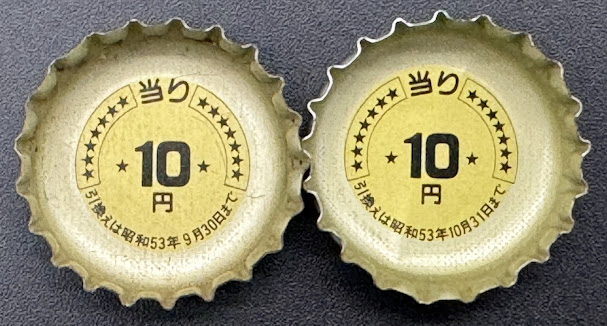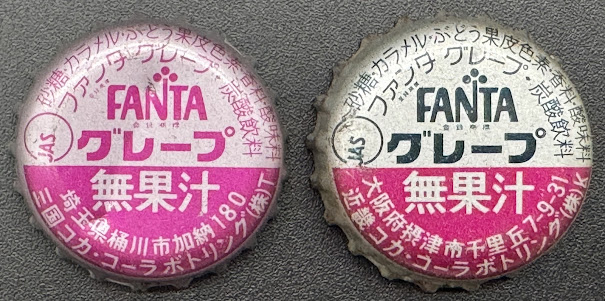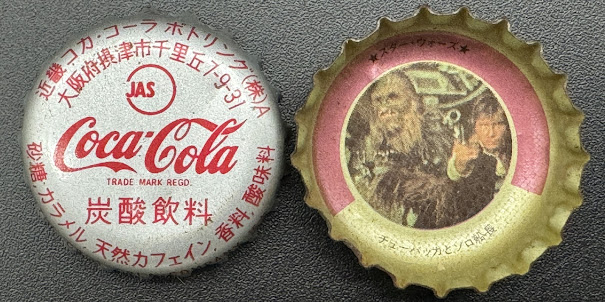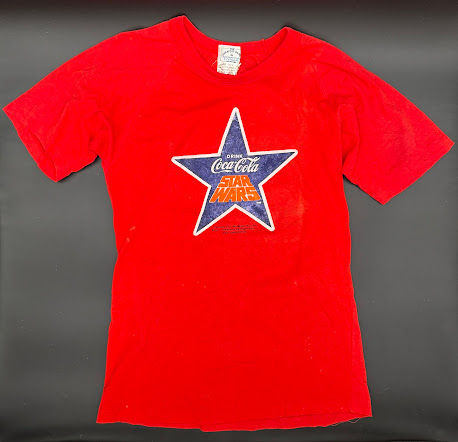Jonathan writes:
The Basics
Star Wars was released in Japan on June 24, 1978, more than a year after it premiered in the United States. A massive promotion involving Coca-Cola brand beverages (Coca-Cola, Fanta, and Sprite) coincided with the film’s highly anticipated Japanese release.
This advertisement, from the pages of Weekly Shōnen Magazine, dated July 2, 1978 announced the campaign.
During the campaign, which ran until the end of August, glass bottles of Coca-Cola brand beverages were topped with collectible metal bottle caps, also known as crown caps or crowns.
The bottle caps were the standard pry-off type (not twist-off) type and usually bear the scars of removal. The undersides of the bottle caps featured a peel-away plastic liner that was an essential part of the bottle-sealing process. In an example of Japanese attention to detail, the liners feature a raised grip with tear-out grooves to facilitate removal. Printed promotional materials included illustrations of the removal process.
As far as I can tell, this style of liner (with grip and grooves) debuted with the 1978 Star Wars campaign. During the Summer of 1977, Coca-Cola offered a Supercar campaign with a set of 100 bottle caps to collect. Promotional materials from that campaign show conventional liners, without any grip or grooves.
The liners are numbered and appear to have been available with numbers ranging from 1 to 24. Presumably the numbering was used for quality control identification during the liner production process. However, that is speculation on my part.
There are at least two different style variations of the liners.
It’s uncommon to find the liners from the Star Wars campaign for a couple reasons. First, the liners were disposable and many consumers would have trashed them. Second, the liners were utilized to participate in the mail-in lottery and purchase aspects of the campaign that are discussed later in this post.
As far as I can tell, the liners used in the Star Wars campaign are unique. During the Summer of 1979, Coca-Cola offered the Red Summer campaign. Promotional paperwork from that promotion included illustrations of liners that feature raised grips and grooves, similar to those from the Star Wars promotion. However, the Red Summer liners are distinguished by the addition of two stars. Note that I haven’t found any of these liners to confirm that the liners produced match the illustrations, but I expect that they did.
To be clear, these liners with stars were not part of the Star Wars campaign.
As with the Star Wars promotion, the 1979 Red Summer liners were utilized in the lottery aspect of the campaign. [1] Presumably, the design change to add the stars would have ensured that only liners from the then-current promotion could be used.
In most cases, peeling away the liner from the underside of the bottle cap revealed one of 50 different images. One of the 50 caps features the familiar Star Wars logo, while the remaining 49 caps feature a photographic image of a scene from the film.
Although the illustrations of the bottle caps on the advertising materials depict full size photo images, the circular images on the production bottle caps are quite a bit smaller than the available flat surface area. Within the ring that surrounding the photo image, “★ スター・ウォーズ ★” (which translates to “★ Star Wars ★”) is printed above the image and descriptive text below the image identifies the character, creature, or scene in the photo. There is no descriptive text below the logo cap.
The bottle caps can be found in two different metallic tones. Most caps are gold-toned, consistent with the illustrations on the advertising materials for the campaign. Less commonly, the bottle caps are silver-toned.
It’s worth noting that there seems to be a subset of images that are harder to find than others. This is anecdotal, based on my personal experience buying bulk lots of caps over a long period of time. While I wouldn’t call any of the images rare, there are definitely some that turn up with less frequency than others. The Star Wars logo cap is among this group. In spite of this, assembling the basic set of 50 bottle caps is an achievable goal, with a bit of persistence.
Lucky consumers peeled away the plastic liners and found one of a handful of instant-winner prize caps. Prize caps included a variety of cash winners, in denominations of 10, 20, 50, 100, or 500 Yen.
Other prize caps included instant-winner caps redeemable for a Free Bottle or a Free T-shirt.
I’ve read that the R2-D2 AM radio was also available via an instant-winner prize cap. However, I haven’t actually seen evidence of this in any of the advertising materials that I’ve collected or reviewed. The individual bottlers seem to have had latitude in how they executed the promotion, so it is certainly possible that one or more of them offered the radio as an instant-win prize.
While the Star Wars campaign took place throughout July and August of 1978, the redemption window for the prize caps extended into the fall of 1978. Most bottlers used a redemption expiration date of September 30, 1978, while some allowed for redemption until October 31, 1978. This image show caps with the two redemption dates.
Note that 1978 was year 53 in the Shōwa era.
The available range of cash winners varied by bottler. From what I can tell, the number of bottlers who offered the Free Bottle and Free T-Shirt bottle caps was quite limited.
As you might expect, all of the prize caps are pretty challenging to find. It would have been an unusual consumer (you know, the obsessive collector type) who kept those caps, rather than redeeming them for the prize.
The matrix below is my work-in-progress list of the available prize caps (click the image to enlarge).
Note that the prize caps matrix is based primarily on my personal collection, supplemented with a review of available advertising materials. It’s a good start, but it is based on a limited pool of data and is something that I’m actively working to develop. If you’ve got variations that I haven’t captured, I’m definitely interested to learn what you have.
Bottlers
In Japan, Coca-Cola was available on a very limited basis as early as the 1910s as an imported product. Domestic production commenced early in the postwar era, but initially it exclusively served the Allied Occupation Forces. Distribution of Coca-Cola products expanded to the private sector in 1957. By 1978, Coca-Cola Japan had expanded to 17 bottlers, each covering a dedicated geographic region. [2]
Most bottlers served more than one Prefecture, but some only served a single Prefecture or, in the case of the Tokyo bottler, a single metropolitan area. This map shows all 17 bottlers and the regions which each covered.
Both matrices included in this post are color-coded to match the regional coloring on the map.
This is a comprehensive look at the beverages produced by Coca-Cola Japan in November 1978, just after the end of the Star Wars campaign.
The red stars denote the beverages that were available from the Okinawa Coca-Cola Bottling Co., Ltd. Each bottler had some discretion about its specific product offerings.
Bottle Cap Anatomy
This is the part where things off the deep end.
When I initially started collecting these bottle caps in 2008, my goal was simply to complete the basic set of 50 images. From the outset, I had a passive interest in flavor variations. But, there is something about the satisfaction derived from assembling complete sets that is really appealing to many collectors, myself included. Before I had finished the basic set of 50 images, I had decided that I really wanted to collect all 50 images for each available flavor as a marathon collecting goal. At the time, I thought there were six flavor variations to pursue.
Collecting my original mixed flavor set of 50 wasn’t too difficult. But, as I write this in 2024, sixteen years after starting this collection, I’ve only been able to complete four of the flavor sets. I’ve also expanded my knowledge of what was available and I’m now pursuing a total of eleven different variations (not just six).
The seven flavors included in the promotion were Coca-Cola, Fanta Apple, Fanta Club Soda, Fanta Grape, Fanta Golden Grape, Fanta Orange, and Sprite. Each bottler had some discretion about which specific products and sizes were included in the campaign. This information can be gleaned from the posters and other printed promotional materials.
The tops of the bottle caps are quite dense with information. The images below provide some translation and guidance to understand what it all means. These images are arranged from most-common (Coca-Cola) to least-common (Fanta Club Soda).
A note about rarity: Fanta Apple bottle caps are uncommon, while both Fanta Golden Grape and Fanta Club Soda bottle caps are rare. The advertising material for more than one bottler states that one or both of the latter two flavors were excluded from the promotion. Certainly not many children were consumers of Fanta Club Soda. It seems likely that those bottle caps would have been primarily consumed in restaurants and bars, where the bottle caps were less likely to have been saved.
The Star Wars campaign happened during a period in time when Fanta Grape was in transition. Fanta Grape was one of the original Japanese Fanta flavors, available to Japanese consumers since 1958. However, in response to consumer demands, artificial coloring agents were replaced with natural coloring agents for all Fanta flavors in 1975. [3] Concerns about the natural purple coloring agent proposed for Fanta Grape led to the flavor being temporarily removed from the Japanese market. Fanta Golden Grape (which was an amber colored beverage) was introduced to take the place of Fanta Grape. Think of it as the white wine of grape sodas.
Fanta Grape was reintroduced in 1977-1978 with natural coloring agents derived from grape skins. For some bottlers, the reintroduction of Fanta Grape began during the summer of 1977, as part of the Supercar promotion. This ambitious promotion was a precursor to the Star Wars campaign, with 100 different Supercar bottle caps from around the world to collect. Promotional materials for the campaign featured Japanese pop music duo Pink Lady.
The reintroduction of Fanta Grape expanded in 1978, with a heavy push during the Star Wars campaign. Unlike the other flavors, which have a uniform appearance regardless of bottler, the individual bottlers took different approaches with Fanta Grape. Both the Kinki and Sanyo bottlers used the conventional approach of black text on the upper half of the bottle cap. For the rest of the bottlers that I've documented, the text on upper half of the bottle cap is purple, possibly as a way to emphasize the new flavor. No bottlers produced both the black text variant and the purple text variant. Each bottler produced either one or the other.
The Chukyo, Kita Kyushu, Michinoku, Minami Kyushu, Nagano, and Shikoku bottlers featured both purple text and the word “new” repeating around the sides of the cap.
I consider the Fanta Grape with black text and Fanta Grape with purple text to be two separate variations, although both were actually the same flavor. Personally, I haven’t further subdivided the purple text caps with and without the repeating “new” text around the sides of the cap to be a separate variation, but your mileage may vary.
There was some overlap of availability of Fanta Golden Grape and the new Fanta Grape. The Shikoku bottler produced Star Wars caps in both flavors.
The other three variations are those which include a pink ring within the area surrounding the upper 2/3 of the photo image on the underside of the bottle cap. These caps were produced solely by the Kinki Coca-Cola Bottling Co. Ltd, which served the Osaka, Kyoto, Hyogo Prefectures within the Kansai (aka Kinki) region of Japan.
Two flavors were available with pink ring caps, Coca-Cola and Fanta Grape, and there are a total of three variations. On all of the Coca-Cola pink ring caps, “★ スター・ウォーズ ★” (translated as “★ Star Wars ★”) is printed in black within the pink ring above the image.
The Fanta Grape pink ring caps can be found both with and without “★ スター・ウォーズ ★” printed in black within the pink ring. For caps without this text, there is pink within pink text which is barely visible within the ring.
The pink within pink text reads “スターウォーズキャンペーン 昭和53年8月31日まで実施中”, which translates to “The ongoing Star Wars campaign ends on August 31, 1978.” Larger text centered within the pink ring reads “ハずれ” (Hazure).
In Japanese giveaways, there is a pairing of 当り (Atari), which means win/winner/hit and 外れ (Hazure), which means lose/loser/miss. If you look at the images above of the instant-winner prize caps, you’ll see 当り (Atari) at the center top, above the Yen denomination (or other prize).
My understanding is that a series of miscommunications led to the use of the pink ring during the initial production run of the Fanta Grape bottle caps for the Kinki bottler. Initially, the caps were printed with the pink text, but no pink ring. After it was determined that the pink Hazure text was not the desired appearance, the text was printed over using a pink ring. The intent was that the pink ring would obscure the text. This approach was pretty effective and explains why the pink within pink text is so hard to read.
The pink ring continued in use for the initial production runs, with “★ スター・ウォーズ ★” printed in black within the pink ring, but was later removed as a running change. So bottle caps produced by the Kinki bottler can be found both with and without the pink ring.
The matrix below is my work-in-progress list of the available bottler-flavor combinations (click the image to enlarge).
The bottler-flavor matrix is something that I’ve been working on for a long time. It is further developed than the prize caps matrix. I’m sure that there are other variations that I haven’t documented. I’m still adding to the matrix fairly regularly.
Here is a collage of the bottle-flavor variations in my current collection.
Many of the bottler-flavor combinations have minor variants denoted by an alphanumeric code which follows the bottler name. I believe that this code denotes the individual bottling plant.
My personal approach to collecting the bottler-flavor variations is to save one example of each that I find. The quantities of potential variants multiplies pretty quickly when you consider the numbers: 50 variants, 17 bottlers, up to 5 bottler codes per bottler, and up to 7 flavors per bottler.
Prizes
The Star Wars campaign involved a number of prizes. I’ve already mentioned a few of them in the discussion of the prize caps above. The main prize was the R2-D2 AM radio, which was widely available, but with regional differences in distribution. Some of the other prizes seem to have had more limited regional distribution.
Several of the bottlers offered free bottles of soda to lucky consumers. Free bottles were available with instant-win bottle caps from the Kinki and Hokuriku bottlers, and likely from some others that I haven’t yet documented. The Kinki bottler offered 2,155,000 free bottles, which could be redeemed for the winner’s choice of Coca-Cola, Fanta, or Sprite.
2,155,000 is a pretty astounding number, considering that the combined population of the Osaka, Kyoto, and Hyogo Prefectures was on the order of 16 million people at the time of the Star Wars campaign.
The Tokyo bottler offered free bottles of the new Fanta Grape with a redemption certificate.
I believe that these certificates may have been inserted into movie programs or otherwise distributed at theaters.
This sheet of die-cut sticker sheet seems to have been available from the Kinki bottler, but I haven’t found documentation of how it was made available.
The Kinki bottler offered 5,000 free T-shirts, which were available by redeeming an instant-win prize cap. The T-shirts could also be purchased for 1,000 Yen plus one bottle cap liner. Presumably some of the other bottlers offered T-shirts, but I don’t believe it was widely available from all bottlers.
The T-shirts are McGregor brand and, for the completist, can be found with two different tag styles. The transfer used on the T-shirts was produced by Factors Etc. Inc. of Bear, Delaware.
Consumers were encouraged to collect the set of 50 caps by advertising materials and by the availability of a plastic tray holder into which the caps could be inserted. Each position on the tray is labeled, such that the caps have specific positions where they should be placed. There are a few bottle caps with duplicate names that are interchangeable. There are three different Han Solo caps, three different C-3PO caps, and two different C-3PO & R2-D2 caps which can be placed interchangeably and still be placed “correctly.”
The tray was vacuformed from white plastic, with a blue header that features the Coca-Cola logo, Darth Vader’s TIE Fighter, and the Death Star. The trays are pretty flimsy and prone to cracking and breakage, especially around the perimeter.
I've bought and sold a number of these trays over the years. They are most frequently filled with bottle caps from the Kinki bottler, so I believe that this is another element of the promotion that had limited regional distribution.
Also available was a papercraft R2-D2 that could be assembled and used to store your hoard of bottle caps. So far, this premium has eluded me.
As mentioned above, the R2-D2 AM Radio was the main prize. It came packaged in a nice red, white, & blue box.
The radio was secured inside a two-part styrofoam insert.
The radio was manufactured by Fuji Electric. Like many white plastics of the era, the radio is prone to yellowing.
An instruction booklet and other paperwork was included with the radio.
The Kinki bottler offered a total of 2,900 Radios available via lottery. It was also possible to purchase a radio for 4,500 Yen plus 5 bottle cap liners. The details are explained on this tri-fold flyer.
The 2,900 Radios from the Kinki bottler were distributed via a series of 8 weekly lotteries. The initial lottery was held on July 15, 1978. Entries had to be postmarked by August 31, 1978.
One of the pages of the flyer could be removed and folded into an envelope to mail in for the weekly lottery. The page features red circles in the positions where the liners were to be affixed to the envelope.
The Tokyo Bottler offered a total of 10,000 Radios in a series of 8 weekly lotteries. This flyer does not include an offer to purchase a radio.
The Sanyo Bottler offered a total of 2,000 Radios in a series of 8 weekly lotteries. This flyer includes an offer to purchase a radio for 4,500 Yen plus 5 bottle cap liners.
The Kita Kyushu Bottler offered a total of 1,600 Radios and the Michinoku bottler offered a total of 2,000 Radios. I don’t yet have data for the rest of the bottlers.
Posters
There is a lot of wonderful advertising material from this campaign, including some fantastic posters.
The so-called “Blowdry Luke” poster is infamous for its depiction of Luke Skywalker with feathered hair. This version of the poster, from my collection, is from the Kinki bottler. It is a Japanese B2 size poster with approximate dimensions of 20”x29”. The instant-winner prize caps for the T-shirt and the Free Bottle are featured in the lower left corner, with the bottler-specific details of the R2-D2 AM Radio lottery in the lower right corner.
These posters were customized to match the details of the campaign specific to each bottler. This poster is from the Kita Kyushu bottler. Notice that it features Yen instant-winner prize caps at lower left. In addition to the Kinki and Kita Kyushu bottlers, there are alternate versions of this poster from the Tokyo, Sanyo, and Michinoku bottlers, and possibly others.
This larger poster is Japanese B1 size with approximate dimensions of 29”x41”, The artwork is signed Shimaoka and it depicts a space battle collage over a large starfield.
Conclusion
The Japanese Coca-Cola promotion of 1978 is fun to collect, with opportunities to collect at various levels of intensity. The bottle caps remain available and are a relatively affordable early collectible. I plan to update the matrixes included in this post in the future, when I reach a critical mass of updated information.
Acknowledgements
Thanks to Martin Thurn for his patient translating assistance over a number of years. Thanks to Toru Komuro for information about the pink ring caps from the Kinki bottler and other sharing of information. Thanks to Pete Vilmur who co-authored a seminal article on this topic for starwars.com back in 2008.
Notes
[1] Information about the 1979 Red Summer promotion is taken from this poster from the Kinki bottler:
[2] This information is taken from a promotional booklet called Chapter 5 Refreshment: Japan’s Coca Cola Industry. The map and available product list are extracted from the same publication, with translations added to the map. Additional information is taken from the book Coca-Cola (Japan) Company, Limited: The First Thirty Years.
[3] This information and other historical information in this post is taken from the book Coca-Cola (Japan) Company, Limited: The First Thirty Years.
















































